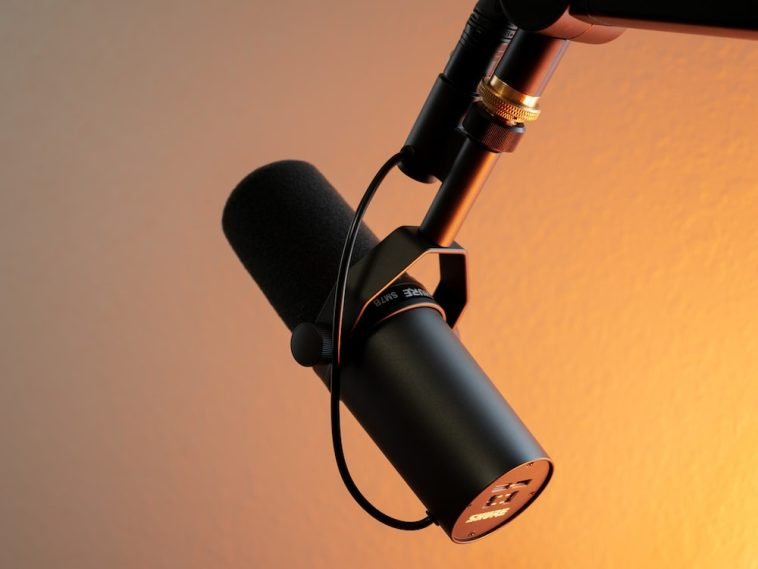Introduction.
When setting up a podcast, lighting might not be the first thing that comes to mind.
Audio tends to steal the spotlight, understandably, but as more people turn to video podcasting on platforms like YouTube and Instagram, the need for great lighting has become essential.
Lighting isn’t just about making things look good—it influences mood, visibility, and how your audience perceives you.
From a dimly lit room that creates a mystery to a bright, welcoming setup, the lighting you choose can impact the way people experience your content.
This guide covers everything you need to know about setting up lighting for your podcast, from different types of lights to setup tips that make a difference.
Why Lighting Matters in Podcasting
Lighting is a key factor in creating a professional look, helping you connect visually with your audience, and giving your brand a polished feel.
With the rise of visual platforms, good lighting has become more than just a perk—it’s almost a necessity.
And it doesn’t have to be complicated or costly. Some basic adjustments can make a big impact, especially if you’re working with a limited budget.
Quality lighting also helps with viewer retention. Studies suggest that audiences are more likely to stick around if they can see the person speaking.
And with algorithms on platforms like YouTube favouring high-quality videos, good lighting can help your podcast get the visibility it deserves.
Types of Lighting for Podcasting
Let’s break down the primary lighting types you’ll encounter when setting up for your podcast:
- Key Light
This is your main light source and does most of the work in illuminating you or your subject. It’s usually placed at a 45-degree angle from the person on camera, creating depth and definition. - Fill Light
The fill light is used to soften shadows created by the key light. Generally positioned opposite the key light, it’s typically less intense, filling in the darker areas without overpowering the main light. - Backlight (or Rim Light)
Placed behind the subject, the backlight adds separation between the person and the background, giving a three-dimensional effect. This can add a more polished look and is especially helpful for avoiding that “flat” look. - Ambient Light
Natural light from windows or artificial lights in the room can affect your setup, too. While not the focus, managing ambient light can be crucial in achieving consistency. - Practical Lights
These are additional lights in the frame that add style or mood—think of a lamp on a desk or a coloured LED strip on the wall. They aren’t essential, but they can add a unique touch to your visuals.
Setting Up Your Lighting
- Determine Your Budget
You can go all out with professional studio lights or keep it simple with affordable LED panels. Starting on a budget? Many podcasters achieve great results with just a couple of lights, so it doesn’t have to be expensive. - Choose Your Location
If you can, position yourself near natural light, like a window, for added brightness. But avoid direct sunlight, which can create harsh shadows. If you’re recording at night or in a windowless room, be prepared to rely entirely on artificial lighting. - Set Up Your Key Light
Position your key light at a 45-degree angle and around eye level. Adjust the brightness until you get a natural look that isn’t overly harsh. A ring light can work well if you’re just starting out and need something straightforward. - Add the Fill Light
On the opposite side of your key light, add a fill light to soften shadows. If you’re using a budget setup, this could even be a table lamp with a lower wattage. Just make sure it’s not as bright as your key light. - Use a Backlight for Depth
Placing a backlight behind you will separate you from the background, creating a nice, professional feel. It’s a subtle touch, but it makes a big difference in video quality. - Adjust Ambient Light
If there’s natural light coming in, work with it instead of fighting it. For evening podcasts, consider covering windows or using curtains to control incoming light.
Pros and Cons of Podcast Lighting Setups
Pros:
- Improved Visual Quality: Good lighting can make any setup look professional.
- Better Audience Engagement: People are more likely to watch content that’s easy on the eyes.
- Enhanced Brand Perception: Consistent, well-lit videos help build a polished brand.
Cons:
- Cost: Quality lighting can get expensive, although budget options exist.
- Setup Time: Adjusting and perfecting lighting takes time, which can be a hassle for quick recordings.
- Space Requirements: Lights can take up space, so small rooms may feel cramped.
FAQs About Podcast Lighting
Q1: Can I use just one light for my podcast?
Yes, you can use a single key light to create a basic, well-lit setup. However, adding even a simple fill light can help reduce shadows and give a more polished look.
Q2: What’s the ideal color temperature for podcast lighting?
Aim for a color temperature between 3200K and 5600K, which mimics natural daylight and gives a balanced look on camera.
Q3: Is natural light enough for podcast lighting?
Natural light can work if you’re recording during the day and have good control over the brightness. But be mindful that it changes throughout the day, which can impact consistency.
Q4: Do I need expensive equipment for good lighting?
Not necessarily. Budget-friendly options like softbox lights, ring lights, or LED panels can achieve a professional look. The most important part is positioning your lights well.
Wrapping It Up
Lighting can truly transform a podcast from casual to professional. It doesn’t just make things look brighter; it sets a mood, helps you connect visually with your audience, and creates a quality that reflects well on your brand.
Whether you’re going for a clean, crisp look or a more relaxed vibe, there’s a setup out there that can meet your needs.
So, now that we’ve covered the basics, what lighting setup are you thinking of trying for your next podcast?





GIPHY App Key not set. Please check settings